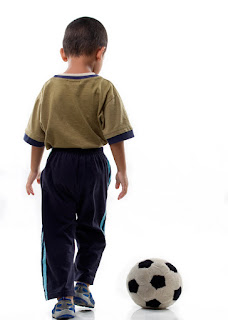Why is it so hard for young children to focus learning sports?
Introduction
Research says, youth’s involvement in sports, music,
and/or the arts can promote positive psychological and emotional development
(Fraser-Thomas et al., 2005). A
significant factor in maximizing positive outcomes of children’s participation
in sports is the quality
of adult leadership inside the program, and their ability to design physical activities
that are fun and inspiring, and promote movement and exploration (Hedstrom
& Gould, 2004). Coaches, parents and
teachers play important roles in building and sustaining motivation inside children's sports experiences (Hoyle & Leff, 2002).
The Problem
Unfortunately, a big problem with sports today is leadership inside most young children's sports experiences is missing. Young children, especially, struggle with focus inside sports because there is a lack of resource adults can turn to that specifically describe how young children learn sports, and that outlines the degrees of difference between how young children and older children learn. As a result activities are poorly designed and lacking in fun and inspiration, and don't promote movement and exploration.
Significance of the Problem
The decrease in schools’ emphasis on physical
activity combined with society’s shift towards two full-time working parent
households has made family life busier.
Parents are increasingly more reliant upon non-educational institutions
to provide outlets for their children’s physical activity (Engstrom,
2004). Unfortunately, parks and recreation literature reveals less than 40% of children's time spent in organized programmed activities qualifies as moderate or vigorous physical activity (West & Shores, 2008). They write, even common "go-to" outlets, like parks and recreation, are falling short amidst schools' physical education and recess reductions. Additionally, they deduce that when a rise in children's average time spent, 5.5 hours, in front of a screen (e.g. television, videos, video games and computers) are included the incidence of childhood obesity becomes relative.
Building Young Children's Focus
Building young children's focus often begins with designing positive psychological and emotionally
enriching environments; this requires providing children a) physical activity
involving choice, b) contrast in what one experiences daily, c) novel,
challenging and meaningful activity, d) social support, e) coherent complexity,
f) a manageable level of stress, g) sufficient time for learning, and h) good
nutrition (Cleland, 2011).
Youth sports, physical education, and child
development literature promote the psychological and emotional outcomes for active
children, including higher self-esteem, confidence and comfort exploring new
activities, and an “I can do!” attitude that leads to increased desires to participate
and a sustainable resilience (Twist and Anderson, 2006, p. 44). Further, Conroy’s (2006) research described
how sports experiences have been positively correlated to:
- · High school athletes’ liking of school
- · Lower dropout rates
- · Higher grade point averages
- · Increased likelihood to attend college
- · Decreased feeling of social isolation
- · Greater occupational success
Cleland (2011) studied the impact of learners
through enriched physical education environments. She wrote,
There
is a plethora of research about the relationship of enriched environments and
brain function. Documented physiological
responses include but are not limited to changes in blood flow with the brain,
increased connectivity between neurons (i.e. enhanced electrical signaling),
protection from stress, as well as the production of new brain cells and
special proteins important for the brain’s survival (p. 5).
Conclusion
Commitment to building enriched learning
environments and allowing children to explore and master them provides young
children with a sense of purpose (Cleland, 2011). She writes, “(Preschool-aged
children’s) thinking is influenced by fantasy – the way they would like things
to be – and they assume that others see situations from their viewpoint” (p.
5). Building fantasy into sports experiences for young children requires letting go of the realism and competition of our adult sports world and designing enriching sports programs that meet young children's expectations of fun and inspiration.


Comments
Post a Comment